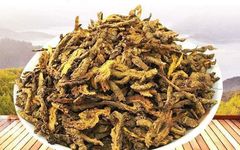
■Editor: Qiao Qiao
Huang Lian (Coptis) and Hu Huang Lian (Picrorhiza) are both commonly used traditional Chinese medicines. The only difference is one character, which can lead beginners to confuse them as the same herb. However, although both are bitter, cold, and dry dampness, they are completely different materials, and thus should be distinguished in clinical applications. In this issue, we will introduce their similarities and differences.
Huang Lian (Coptis)
 Huang Lian, also known as Wei Lian, Chuan Lian, or Ji Zhua Lian, is the dried rhizome of the Ranunculaceae plant Coptis chinensis Franch., Coptis deltoidea C.Y. et Hsiao, or Coptis teeta Wall.; it is bitter in taste and cold in nature; it enters the Heart, Spleen, Stomach, Liver, Gallbladder, and Large Intestine meridians; it has the effects of clearing heat, drying dampness, purging fire, and detoxifying. It is primarily used for treating damp-heat obstruction, vomiting with sour regurgitation, dysentery, jaundice, high fever with delirium, excessive heart fire, irritability and insomnia, palpitations, blood heat with vomiting or nosebleeds, red eyes, toothache, thirst, and carbuncles; it can also be used externally for treating eczema, damp sores, and purulent ear discharge.
Huang Lian, also known as Wei Lian, Chuan Lian, or Ji Zhua Lian, is the dried rhizome of the Ranunculaceae plant Coptis chinensis Franch., Coptis deltoidea C.Y. et Hsiao, or Coptis teeta Wall.; it is bitter in taste and cold in nature; it enters the Heart, Spleen, Stomach, Liver, Gallbladder, and Large Intestine meridians; it has the effects of clearing heat, drying dampness, purging fire, and detoxifying. It is primarily used for treating damp-heat obstruction, vomiting with sour regurgitation, dysentery, jaundice, high fever with delirium, excessive heart fire, irritability and insomnia, palpitations, blood heat with vomiting or nosebleeds, red eyes, toothache, thirst, and carbuncles; it can also be used externally for treating eczema, damp sores, and purulent ear discharge.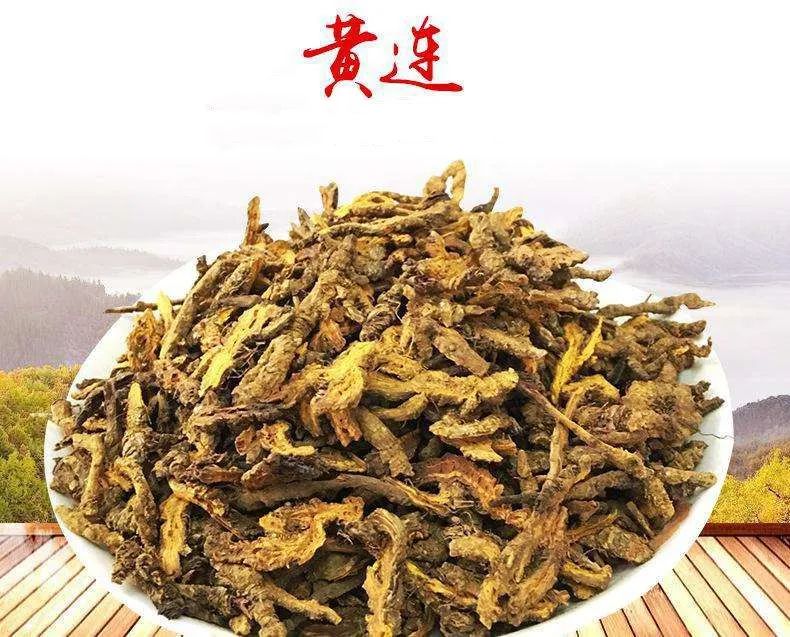
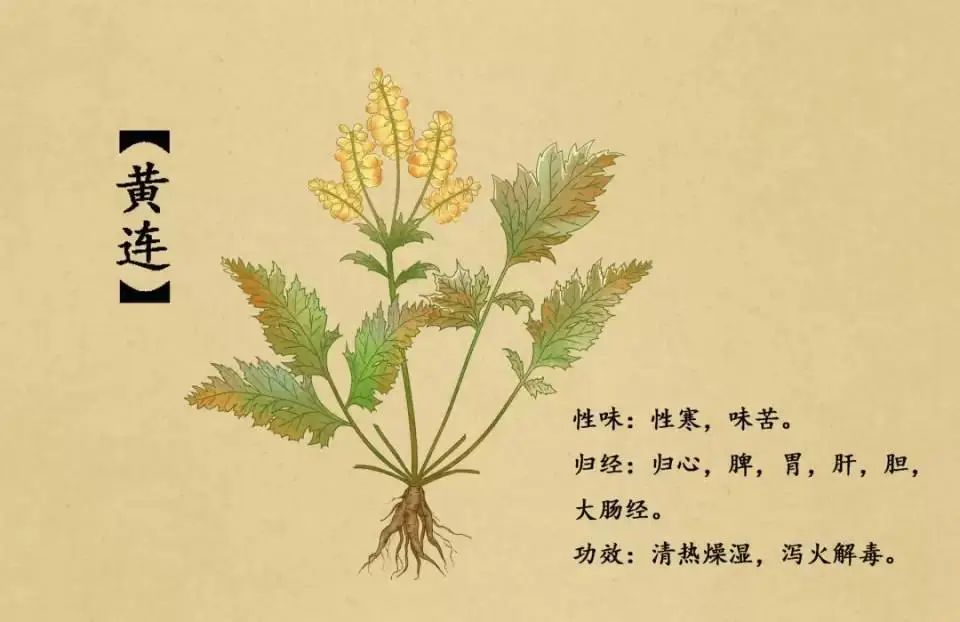 Characteristics: It often clusters, is usually curved, resembling a chicken’s claw, with single branches of rhizome measuring 3-6 cm in length and 0.3-0.8 cm in diameter. The surface is grayish-yellow or yellow-brown, rough, with irregular nodular protrusions, fibrous roots, and remnants of fibrous roots; some segments have a smooth surface like a stem.
Characteristics: It often clusters, is usually curved, resembling a chicken’s claw, with single branches of rhizome measuring 3-6 cm in length and 0.3-0.8 cm in diameter. The surface is grayish-yellow or yellow-brown, rough, with irregular nodular protrusions, fibrous roots, and remnants of fibrous roots; some segments have a smooth surface like a stem.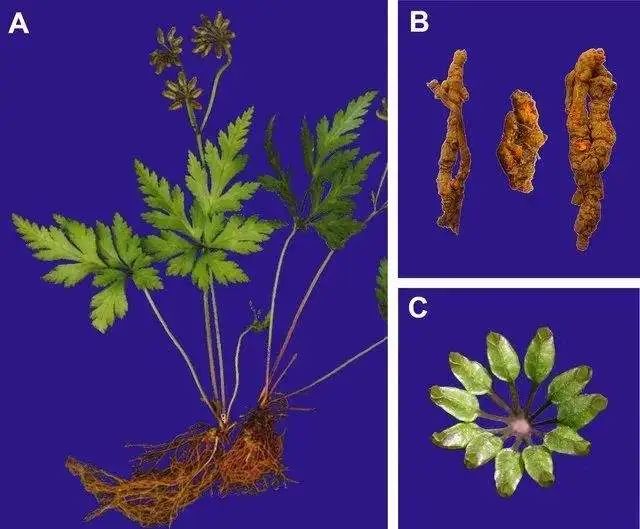
Hu Huang Lian (Picrorhiza)
 Hu Huang Lian is the dried rhizome of the Scrophulariaceae plant Picrorhiza scrophulariiflora Pennell; it is bitter in taste and cold in nature; it enters the Liver, Stomach, and Large Intestine meridians; it has the effects of clearing damp-heat, relieving bone steaming, and dispelling summer heat; it is primarily used for treating damp-heat dysentery, jaundice, hemorrhoids, bone steaming, and pediatric summer heat.
Hu Huang Lian is the dried rhizome of the Scrophulariaceae plant Picrorhiza scrophulariiflora Pennell; it is bitter in taste and cold in nature; it enters the Liver, Stomach, and Large Intestine meridians; it has the effects of clearing damp-heat, relieving bone steaming, and dispelling summer heat; it is primarily used for treating damp-heat dysentery, jaundice, hemorrhoids, bone steaming, and pediatric summer heat.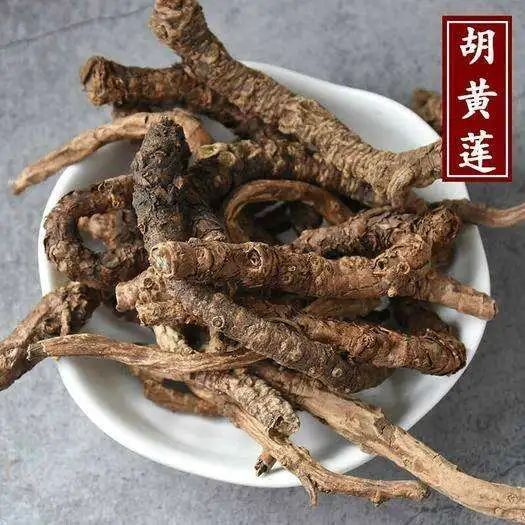 Characteristics: It is cylindrical, slightly curved, occasionally branched, measuring 3-12 cm in length and 0.3-1 cm in diameter. The surface is gray-brown to dark brown, rough, with dense ring-like nodes, slightly raised bud scars or root scars, and the upper end is densely covered with dark brown scale-like leaf stalk remnants.
Characteristics: It is cylindrical, slightly curved, occasionally branched, measuring 3-12 cm in length and 0.3-1 cm in diameter. The surface is gray-brown to dark brown, rough, with dense ring-like nodes, slightly raised bud scars or root scars, and the upper end is densely covered with dark brown scale-like leaf stalk remnants.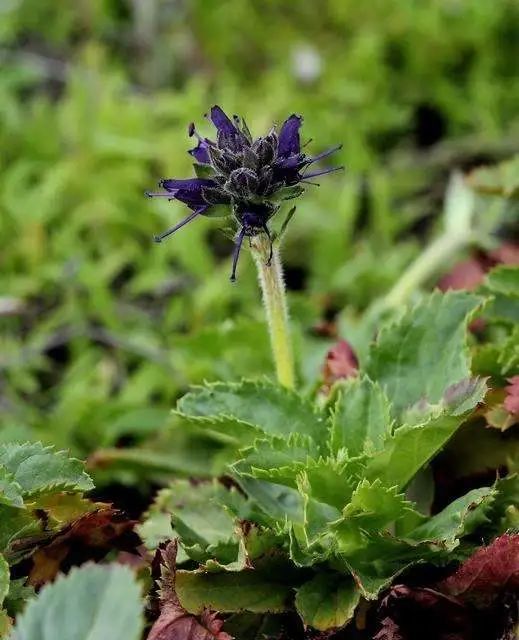
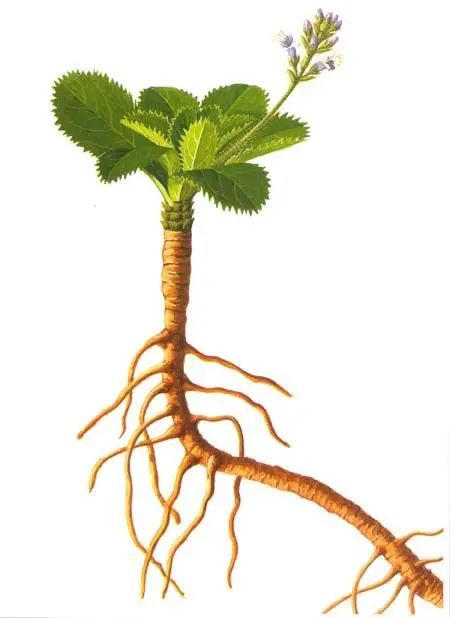
Huang Lian (Coptis) VS Hu Huang Lian (Picrorhiza)
 1. Different species of medicinal materials: Huang Lian is the dried rhizome of the Ranunculaceae plant Coptis chinensis Franch., Coptis deltoidea C.Y. et Hsiao, or Coptis teeta Wall. Hu Huang Lian is the dried rhizome of the Scrophulariaceae plant Picrorhiza scrophulariiflora Pennell.2. Different effects: Huang Lian has the effects of clearing heat and drying dampness, and purging fire and detoxifying, making it very effective for the accumulation of dampness and heat toxins in the body. Hu Huang Lian has the effect of clearing deficiency heat, can reduce deficiency heat and dispel summer heat, and is effective in treating internal deficiency heat caused by poor lifestyle and dietary habits.3. Different diseases treated: Huang Lian can effectively treat gastrointestinal damp-heat, quickly alleviating diarrhea and dysentery caused by gastrointestinal damp-heat, as well as nausea and vomiting, especially effective for high fever and irritability caused by febrile diseases, and can effectively alleviate or detoxify carbuncles. Hu Huang Lian is effective for diseases such as labor heat and bone steaming caused by yin deficiency heat, as well as irritability in the five hearts.Source: “Huang Lian” “Hu Huang Lian” Chinese Pharmacopoeia 2005 edition, Xu Weihua “What is the difference between Hu Huang Lian and Huang Lian?” Popular Health NetworkThank you for reading and sharing
1. Different species of medicinal materials: Huang Lian is the dried rhizome of the Ranunculaceae plant Coptis chinensis Franch., Coptis deltoidea C.Y. et Hsiao, or Coptis teeta Wall. Hu Huang Lian is the dried rhizome of the Scrophulariaceae plant Picrorhiza scrophulariiflora Pennell.2. Different effects: Huang Lian has the effects of clearing heat and drying dampness, and purging fire and detoxifying, making it very effective for the accumulation of dampness and heat toxins in the body. Hu Huang Lian has the effect of clearing deficiency heat, can reduce deficiency heat and dispel summer heat, and is effective in treating internal deficiency heat caused by poor lifestyle and dietary habits.3. Different diseases treated: Huang Lian can effectively treat gastrointestinal damp-heat, quickly alleviating diarrhea and dysentery caused by gastrointestinal damp-heat, as well as nausea and vomiting, especially effective for high fever and irritability caused by febrile diseases, and can effectively alleviate or detoxify carbuncles. Hu Huang Lian is effective for diseases such as labor heat and bone steaming caused by yin deficiency heat, as well as irritability in the five hearts.Source: “Huang Lian” “Hu Huang Lian” Chinese Pharmacopoeia 2005 edition, Xu Weihua “What is the difference between Hu Huang Lian and Huang Lian?” Popular Health NetworkThank you for reading and sharing They are reading:① “New Chinese Medicine and Clinical Pharmacology” statement② Congratulations! Our journal has 473 papers selected in the China National Knowledge Infrastructure “Academic Essentials Database”③ Contents of Issue 10, 2022
They are reading:① “New Chinese Medicine and Clinical Pharmacology” statement② Congratulations! Our journal has 473 papers selected in the China National Knowledge Infrastructure “Academic Essentials Database”③ Contents of Issue 10, 2022
[Statement]The copyright of the images and text belongs to the original rights holder, and this platform is for non-commercial use. The views expressed are solely those of the author and do not represent the position of this platform. This article is published by the Traditional Chinese Medicine New Drug WeChat platform, please respect others’ labor, and when reprinting, please indicate “Reprinted from Traditional Chinese Medicine New Drug (zyxylc)”! Direct copying without indicating the source is prohibited!Warm reminder: The journal “New Chinese Medicine and Clinical Pharmacology” does not accept email submissions, please submit through the official website, website: http://www.zyxy.com.cn (you can directly click on “Read the original text” at the end). If this article infringes your rights, please contact us in a timely manner for authorization or prompt deletion!
Traditional Chinese Medicine New Drug ∣Official account of a professional journal
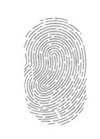 Long press, identify the QR code, and follow us
Long press, identify the QR code, and follow us

